Humor Keeps Teens and Tweens Reading. Why Isn't There More?
Librarians call for more funny, fast-paced YA for teens who've outgrown the "Diary of a Wimpy Kid" stage.

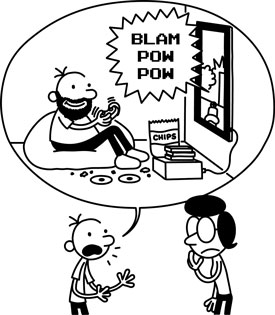 |
Sorry, but Greg Heffley will not age up, says “Diary of a Wimpy Kid” creator Jeff Kinney.TM and © 2007-2022, Wimpy Kid, Inc. |
What do fans of “Diary of a Wimpy Kid” read in high school? The shelves of any teen section in a library or bookstore are dominated by black covers featuring swords, wings, and shadows. Some of the tomes are so large, they need to be held with two hands.
While this is nothing new—many YA books are long and dark—it raises the question: Are there enough funny books for tweens and teens? Or is the future of YA one of doom, gloom, and romance?
Librarians want humor. A recent campaign on Twitter led by Kelsey Bogan, a high school librarian in West Chester, PA, begged publishers for more of it, now.
“In elementary and middle school, our students often love—become obsessed with, even—those diary-style, laugh-out-loud, graphic/prose combo books like ‘Diary of a Wimpy Kid,’ ‘Big Nate,’ ‘Dork Diaries,’ etc.,” Bogan says. “Then, all of a sudden, when they hit high school and the ‘Young Adult’ section of publishing, that need is simply no longer met.”
She adds, “It’s ridiculous to me that these kinds of funny and fast-paced stories are so demonstrably popular, that publishers must know how much demand there is for them, and yet these stories abruptly cease when students age into the YA market.”
Jeff Kinney, creator of “Diary of a Wimpy Kid,” is flattered people are calling for aged-up Greg Heffley. But he doesn’t think that is his domain.
“I’ve found that some readers continue reading my books as a sort of guilty pleasure into their high school years, but it would be great if there was a subgenre of hybrid comedy books that spoke more directly to a teenager’s authentic experience,” Kinney says. “A lot of books aimed at teens focus on difficult subject matter, which is fertile territory for exploration. But there’s a lot of levity in the teenage years as well. I think it makes perfect sense that someone could come up with a line of books with more grown-up subject matter, but with humor as a focus.”
“I’ve always seen Greg as being at childhood’s end, staring down the Great Unknown of being a true teenager,” Kinney adds. “That’s the territory I’m comfortable working within. Anything beyond that is better explored by authors who have a better handle on the authentic mentality of a young adult.”
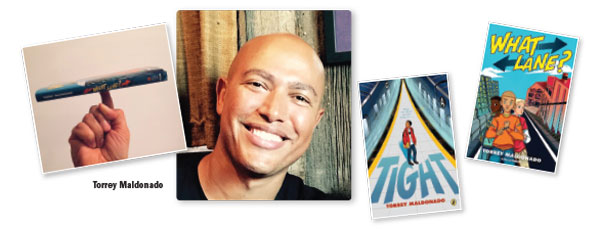
Statistically speaking
In a recent issue of SLJ, the 23 YA books that were reviewed for middle and high schoolers averaged 352 pages. The longest was the 592-page The Nobleman’s Guide to Scandal and Shipwrecks by Mackenzi Lee, and the shortest was 240-page Cold by Mariko Tamaki. The average length of the 19 middle grade titles reviewed, by contrast, was 282 pages, which is 70 pages shorter than the YA average.
Two middle grade reviews mentioned humor or comedy, but no YA reviews contained either keyword. The 2022 Printz Award winner and four Honor titles averaged 379 pages, with topics ranging from drugs and bullying to the Black Panthers and LGBTQIA+ issues. Often these topics also included humor, but it was not a main element in any award winners.
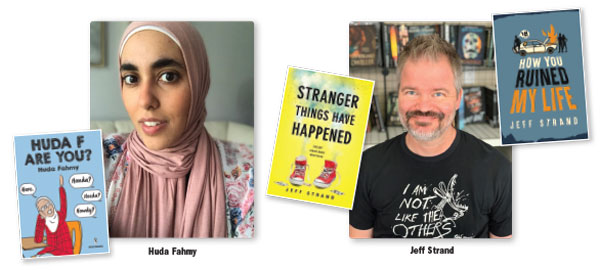
Time for a balance
In addition to flat-out funny, librarians want books that address issues and also have a light touch.
“I’m looking for more lighthearted and humorous novels and graphic novels that address preteen and teen concerns and issues, such as relationships,” says Ryan Tahmaseb, teacher-librarian at Meadowbrook School in Weston, MA. “There are lots of fantastic issue-driven early-YA books, but humor tends to be more incidental in these titles.”
Torrey Maldonado, middle grade author of books including Tight, What Lane?, and Secret Saturdays, calls short and funny writing his “calling card” and keeps his books under the 200-page mark. A photo shows Maldonado balancing his latest book, What Lane?, on one finger, because it’s thin and light enough to do so. It’s about a mixed-race kid trying to find his place in his friend group.
“Every book sends a message—even the cover and size of a book sends a message,” Maldonado says. “When someone picks up my book, I want them to say, ‘This looks unputdownable. This looks finishable.’ I’m lucky because fans and critics say that my books send those messages and deliver on those promises. I intentionally write books whose pages are a lot less [than other books] yet help kids process.”
Maldonado enjoyed comic books growing up and tries to take that energy and apply it to his longer titles. He wants his books to have the “kaleidoscopic energy of comics.” He is filling a gap he saw growing up, he says, of not seeing his peers or community in books he read.
Muslim American author Huda Fahmy got her start creating adult graphic novels that portray real-life situations Muslims encounter. Her latest graphic novel, Huda F are You?, is YA and takes a humorous look at the experience of a Muslim American girl moving to a new town in Michigan with a large Muslim population.
“There are YA books that are written to be funny, and there are manga/graphic novels that are written to be serious,” says Fahmy. “I think comics in general always lead themselves to be funny because of the medium.” As for authors she admires, “I’m motivated by Bill Watterson, Gene Luen Yang, Svetlana Chmokova, Jerry Craft, and Raina Telgemeier. Their art and storytelling is moving, funny, beautiful, and inspirational.”
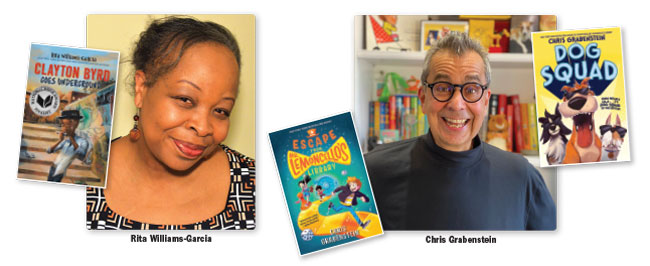
Define “funny”
The question of what defines a funny title, and where these books belong, is where things get complicated.
“I recently genrified our YA collection, and the humor section is our smallest,” Tahmaseb says. “Part of this simply reflects what we’ve ordered. But I also know from ordering books over the years there are fewer humorous options for this age.”
Labeling genres is difficult, says author Jeff Strand, especially with YA and middle grade books that cover multiple topics. Strand started as an adult horror writer and finds that he is branded as a YA horror writer, too, even though many of his YA titles, including Stranger Things Have Happened and How You Ruined My Life, are mainly comedic.
“There aren’t as many funny books for older readers, and I can see why,” says Rita Williams-Garcia, award-winning author of books including One Crazy Summer. “It’s easy to associate teen life with storm and stress. Add all of that angst to an art that demands conflict, and you have a recipe for tragedy. Or, at the least, something weighty. My thought is, adolescents experience more, are exposed to more; therefore, we give them more in story. That doesn’t mean humor and humorous characters can’t be infused. What I like about YA today is writers acknowledge the ups, downs, and complexities of teen life, while incorporating humor.”
Williams-Garcia points to books including Jenni Hendriks and Ted Caplan’s Unpregnant and Joya Goffney’s Excuse Me While I Ugly Cry. “No other generation takes misery and turns it into comedy quite like this generation of writers,” she says.
Comedic middle grade author Chris Grabenstein, author of Escape from Mr. Lemoncello’s Library, agrees that funny and serious books go hand in hand.
“I remember when I was a teenager, a lot of stuff was very serious to me. But I still liked to laugh,” Grabenstein says. “I think humorous books are ‘serious.’ They are a light-touch way to deal with heavy issues and emotions. They just give us a laugh along the way.”
Today, he is drawn to a wide range of authors. “I love books by Christopher Paul Curtis, Stuart Gibbs, Jenni Holm, Lamar Giles, Steve Sheinkin, Kwame Alexander, and so many others, because they all tell stories that grab my attention and never let it go.”
Betsy Bird, librarian, blogger at “A Fuse #8 Production,” and author, recalls asking Jon Scieszcka why more funny books didn’t win awards.
Humor Picks by
|
“He said something along the lines of, ‘If a dog dies, it’s sad and everyone agrees. But funny, we all have different opinions on what funny is,’” Bird recalls.
It was during the initial “Wimpy Kid” craze that Bird was inspired to edit the book Funny Girl, an anthology of short stories by women writers. She noticed that when kids were asking for “Wimpy Kid” read-alikes, she wasn’t finding titles by female authors. Funny Girl, published in 2017, has 29 contributors, with authors including Williams-Garcia, illustrators, comic artists, editors, comedians, and TV writers.
Bird says although her initial pitch took time to land with a publisher, the book found immediate success once published. “Funny Girl is my most successful book,” Bird says. “It keeps going and going. There is an unending need for it.”
Icebreakers for reading
Sometimes, overworked students just need a dose of humor. Neha Thakkar, school librarian/instructional technology coordinator at the K–8 Avery Coonley School in Downers Grove, IL, says that her older kids need a break from the many intense titles they are required to read.
“My seventh graders are reading Just Mercy and To Kill a Mockingbird,” Thakkar says. “For lack of a better term, they need beach reads for teens.”
She also finds that her middle school students read at a higher academic level, but aren’t ready for a lot of the social and emotional themes that come with young adult books.
“It’s important for teens to read the classics and write reports on symbolism and foreshadowing and stuff,” Strand says. “But when their only reading comes from having to endure Wuthering Heights for English class, a lot of kids mistakenly believe that they don’t like to read. If they can balance the reading that they have to work at with stuff that’s purely entertaining, they’re less likely to graduate and shout, ‘Woo-hoo! I never have to read a book ever again!’ ”
“Humorous books have the added benefit of attracting kids who haven’t read anything for pleasure in a while,” Tahmaseb adds. “When someone you just met makes you laugh, it breaks the ice. This is true interpersonally, but it’s also true in the reader/book relationship.”
Williams-Garcia says that the tone of her books has changed over the years. Her books can be classified as funny as well as serious required reading. Her most recent title, A Sitting in St. James, is a 460-page YA novel that is serious historical fiction addressing the moral issues of slavery, while Clayton Byrd Goes Underground is a short, lighthearted middle grade read that combines complicated relationships with everyday school drama.
“In my early career, I wrote about serious subjects to get out what I needed to say about topics I didn’t think were being covered,” Williams-Garcia says. “But I’m a lighthearted person. My twitter handle, @onecrazyrita, isn’t so much a play on my middle grade title, but a self-descriptor. I can be a little wacky, exuberant. A big kid at heart. It was time to expose my inner 11-year-old, so I changed the tone of my work.”
Williams-Garcia also finds herself considering whom funny books might offend. “Do we spare characters representing marginalized people from being at the center of humorous things gone wrong?” Garcia asks. “Our ability to create and appreciate humor sets us apart from all other beings. I have no answer. I just think about this. A lot.” She also cites the current political climate as a concern: an assistant principal recently lost his job after reading a funny picture book, I Need a New Butt!, to a group of second graders.
For this generation of kids and teens living with a lot of serious world problems, the demand for funny books and the escape they offer isn’t going anywhere. Kinney says Greg Heffley, “suspended in a pre-adolescent amber” throughout the series, can offer support through troubled times.
“A cartoon character is a promise, in a way,” Kinney says. “Your life might change, but a cartoon character stays the same. I think some kids take comfort in that, even when they’ve outgrown the series.”
Emily Mroczek-Bayci blogs at “Heavy Medal.”
RELATED
The job outlook in 2030: Librarians will be in demand
The job outlook in 2030: Librarians will be in demand
ALREADY A SUBSCRIBER? LOG IN
We are currently offering this content for free. Sign up now to activate your personal profile, where you can save articles for future viewing


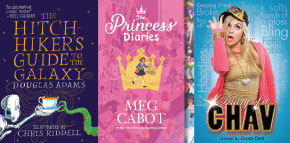
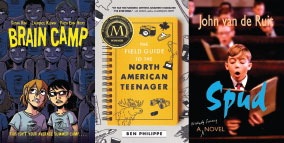




Add Comment :-
Be the first reader to comment.
Comment Policy:
Comment should not be empty !!!